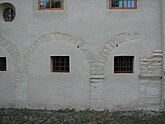St. Petri (Brumby)
The Church of St. Petri is the evangelical sacred building in Brumby , part of Staßfurt in Saxony-Anhalt . The parish belongs to the Egeln parish of the Evangelical Church in Central Germany . Because of the 92 ceiling picture plates it is considered a special "picture church", since 2006 it has also been a motorway church .
history
The single-nave St. Peter Church in Brumby has more than eight centuries of history. It is of Romanesque origin and was built in the 12th century. On the outer south wall of the nave you can clearly see the walled-up upper clad windows and round arches with the Romanesque battlement plates. They suggest that the church was originally a small three-aisled basilica and that it has undergone several renovations over time.
In the Gothic period, the central nave was lengthened and provided with a semi-octagonal choir. During this time, the tower was raised by two stories and opened on the west side with a pointed arched door.
With the renovation in the years 2000 to 2002, the quarry stone image of the church was preserved.
Church tower with five points
The most striking feature of the church from the outside is the striking, five-pointed tower with a main peak and four secondary peaks of the small corner towers at the tower corners, which can be seen from afar.
At the end of the 19th century, the simple hipped roof church tower was to be renovated. Because of this, a church tower dispute broke out in the community in 1899. The parish councilor at the time, the manor owner of Alvensleben and the pastor, however, pleaded for a simultaneous renovation of the roof in order to give the old roof a pleasing appearance and not be inferior to the new buildings of some parishes in the district. The majority of the population was against these turrets - but in vain.
People's opinion was not taken into account, the spire was redesigned according to the plans. Since then, the tower has had its characteristic four small corner turrets - and St. Peter's Church in Brumby has had an individual silhouette to this day.
Furnishing
After the church had been abused as a stable for a while during the Thirty Years' War, the parish under the church patron Gebhard von Alvensleben (1618–1681) and under the direction of Pastor Heinrich Hävecker (1610–1676; father of Johann Heinrich Hävecker ) began with her after the war Renewal and outstanding equipment that was completed after a few years. The baroque interior of the church is also a special testimony to the medieval wealth of the Börde thanks to the fertile soil.
“The interior of the St. Petri Church in Brumby, a village about 30 kilometers south of Magdeburg, is considered to be one of the best examples of the North German Baroque, which sets the church apart from other churches in the surrounding Bördedörfern. 92 panels on the Christian doctrine of salvation decorate the ceiling, gallery and pulpit. Together they form a total work of art, 'a painted Bible'. "
Picture-rich coffered ceiling
In 1664, Hävecker commissioned the carpenter Hans Reiche from Calbe to manufacture the wooden coffered ceiling. The painter Heinrich Busch from Braunschweig was then commissioned to draw biblical ceiling pictures on the coffered ceiling. Busch achieved this with high artistic quality - within two years he created 92 paintings.
The centerpiece is the ceiling pictures in the middle row, which tell the story of God's salvation with man from creation to the Last Judgment. The adjacent rows explain the images in the middle row through stories from the Old and New Testaments. The outer rows represent biblical people.
In May 2018, 135,000 euros in public funding were approved for the renovation of the ceiling paintings.
Pulpit and altar
The pulpit was created in 1665–1667 by the carpenter Melchior Stellwagen from Halle. It shows the four evangelists and Jesus as the good shepherd.
The altar from 1667 comes from Wilhelm Schorius from Braunschweig. The wooden figures show the triumphant Christ with two angels in the upper row, the four evangelists with their symbols in the middle and Peter, the horned Moses, the Baptist John and Paul in the lower row.
organ
In 1672 Jakob Schüler from Magdeburg built the organ ; in 1869 it was replaced by master organ builder Adolf Reubke while retaining the wooden front . Magdeburg cathedral organist August Gottfried Ritter took over the planning and acceptance . At the beginning of the 20th century, four registers were replaced by Ernst Röver. During the First World War, the prospect pipes had to be handed in for war purposes and were replaced nine years later. In 1932 a new gaming table was installed by the Sauer company. In 1988 the organ was serviced and cleaned, after which the organ was regularly looked after by the company Orgelbau Reinhard Hüfken . Today the organ has 17 stops on two manuals and a pedal . The disposition is:
|
|
|
|||||||||||||||||||||||||||||||||||||||||||
present
- Autobahn Church
In 1997 there was an initiative to build a motorway chapel on the A 14. However, the implementation failed because of the question of sponsorship. In August 2000, while driving on the motorway from then Minister for Roads and Urban Development of Saxony-Anhalt, Jürgen Heyer, the idea arose to use St. Petri Church in Brumby as a motorway church .
The prerequisites for opening the parish church as a motorway church were created. On May 18, 2006, Bishop Axel Noack officially released the church as a motorway church. Since then, it has been open to motorway travelers for breaks and refreshments.
The church is open daily from 9 a.m. until dark. In its capacity as a parish church, the church services of the parish are also celebrated in this motorway church.
photos
See also
"Picture churches":
literature
- Gottfried Eggebrecht (pastor): St. Petri Church Brumby - Schönebeck district . Leaflet (front side) + poster (back side), format A2, colored, folded, no year (probably before 2006, as the Autobahnkirche project is not mentioned)
- Bernhard Pabst: Heinrich Haevecker, Johann Heinrich Haevecker. "... that one has, as it were, a little Biebel in such beautiful paintings and pictures ...". The baroque village church Brumby in circles Schoenebeck / Elbe and the parish family Haevecker - the historical description in the fair preaching 1671. . PDF download, 110 pages, A4 format. With an introduction by Bernhard Pabst. Bonn 2006
- Newspaper articles
- Daniel Wrüske: Jubilee in Brumby - Church for large congregations . Volksstimme , May 19, 2016
- Daniel Wrüske: Autobahnkirche - This is the place where the soul can recharge . Volksstimme, May 18, 2016
- Daniel Wrüske: Petrikirche Brumby - image for faith . Volksstimme, July 13, 2015
Web links
- https://www.autobahnkirche.de/abk/autobahnkirchen/25_A14_Evangelische-Autobahn-und-Gemeindekirche-St-Petri-Brumby.html#Architektur - accessed on November 26, 2018
- http://www.kirche-brumby.de/
- Franziska Richter: 135,000 euros for the picture ceiling - joy in the Brumby parish: With funding, many ceiling pictures in the church can now be restored. Volksstimme , online portal, contribution from May 5, 2018. Retrieved November 26, 2018 .
Individual evidence
- ↑ Heinrich Hävecker, Johann Heinrich Hävecker: "... that one has a little Biebel on such beautiful paintings and pictures ..." The baroque village church of Brumby in the Schönebeck / Elbe district and the Hävecker parish family - the historical description in the parish sermon 1671. With an introduction by Bernhard Pabst. (= Writings on the history of the Pabst family . Volume 31 ). 2nd Edition. Bonn 2006, p. 110 , urn : nbn: de: gbv: 3: 2-51795 ( Online [PDF; 2.9 MB ; accessed on April 22, 2020]).
- ↑ Franziska Richter: 135,000 euros for the picture ceiling - joy in the Brumby parish: With funding, many ceiling pictures in the church can now be restored. Volksstimme , online portal, contribution from May 5, 2018. Accessed November 26, 2018 .
- ↑ Felix Friedrich, Vitus Froesch: Organs in Saxony-Anhalt - A Destination Guide. Verlag Klaus-Jürgen Kamprad, Altenburg 2014, ISBN 978-3-930550-79-1 , p. 242.
- ↑ 25. Evangelical Motorway and Parish Church of St. Petri, Brumby ( Memento from April 11, 2016 in the Internet Archive )
Coordinates: 51 ° 53 ′ 42.8 " N , 11 ° 43 ′ 3.1" E














